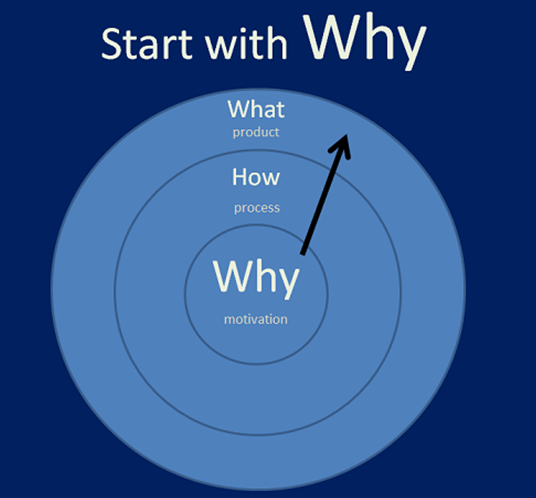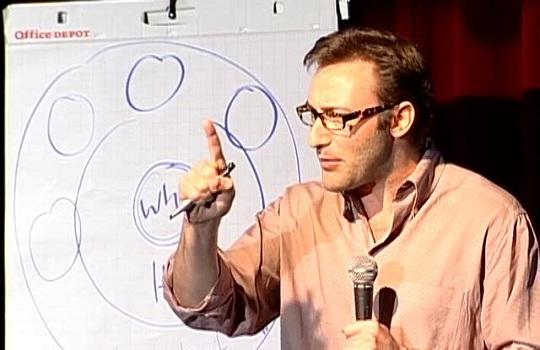This article is a summary of Simon Sinek's TED Talk, which asks how great leaders inspire action. His talk is the most-viewed of all time – many millions of people have tuned in.
How do you explain when things don’t go as you assume? And, more importantly, how do you explain when others are able to achieve things that defy that assumption?
Here’s a question lots of people ask: why is Apple so innovative? They’re just another computer company. They have the same access to talent, media, consultants, etc, so why is it that seem to have something different?
Why did Martin Luther King lead the civil rights movement? He wasn’t the only great orator of the day?
Why could the Wright Brothers work out controlled flight when other teams couldn’t?
There’s something else at play here. Three and a half years ago I made a discovery and this profoundly changed my view on how the world works.
There’s a pattern – all great inspiring leaders and organisations in the world think, act and communicate the same way. It’s the complete opposite to how others do it.
It’s the world’s simplest idea. I call it the Golden Circle –

EVERY organisation knows WHAT they do. Some know HOW they do it – this might refer to their USP. But VERY FEW organisations know WHY they do what they do. And I don’t mean to make a profit, because that’s a result. I mean what’s the purpose, belief or cause.
Why does your organisation exist? Why should people care? What difference do you make?
All the best organisations act from the inside out. If Apple were like everyone else, a marketing message might sound like ‘We make great computers. Easy to use, well-designed and user-friendly. Want to buy one?”
We say what we do, we say why we’re different and we expect behaviour – a sale, a vote, etc.
Here’s how Apple actually communicates – “Everything we do, we believe in challenging the status quo and thinking differently.” And it changes the message that they present.
People don’t buy what you do, they buy why you do it.
This explains why every single person in this room is perfectly comfortably buying a computer from Apple – but also an MP3 player and a phone and a tablet. But they are just a computer company – nothing really differentiates them from their competitors! And their competitors are well-placed to make other products – but people don’t buy them! Can you imagine buying an MP3 player from a ‘normal’ computer company?
The goal is not to do business with people who NEED what you HAVE, but to do business with people who believe what you BELIEVE.
Here’s the best part: none of this is opinion. It’s all grounded in biology, not psychology.
Our neo cortex corresponds with the WHAT level – that’s our most advanced part of the brain
But OUR limbic system – our more ancient brain – is concerned with the WHY and HOW. It’s responsible for FEELINGS e.g. trust and loyalty, decision-making and behaviour and it has no capacity for language.
Sometimes you can give people all the facts and figures and they say “Ohhhh, I know the benefits but it just doesn’t FEEL right.” Why do we say that? “It doesn’t feel right.” People say this because the part of the brain that drives behaviour can’t process language.
When people say they lead with the heart and soul, they mean the limbic system.
The goal is not just to hire people who need a job but to hire people who believe what you believe.
If you hire people who can do a job they’ll work for money – if you hire people who believe in what you believe they’ll also work with blood, sweat and tears.
People don’t buy what you do, they buy why you do it. You must talk about what you believe if you want to attract the people you want to attract.
The Law of Diffusion of Innovation – how to get people to believe what you believe
The first 2.5% of our population are innovators. The next 13.5% are early adopters. The next 34% are the early majority. The next 34% are the late majority and the final 16% are the laggards.
The only reason laggards buy touchtone phones is because you can’t buy rotary phones any more.
We sit at different points at different times on the scale.
But, what this tells us is that if you want mainstream awareness, you can’t achieve it until you have 15 – 18% market penetration – and then the system tips.
And I love asking businesses – what’s your conversion on new business? And they say, oh 10%, and – well you can trip over 10% of your customers – they’re the ones who just get it – the key is finding these people before they’re actually customers!
Crossing the chasm – you have to close the gap. Late adopters won’t try something until the innovators and the early adopters have done it first.
Innovators and early adopters are much more comfortable making those intuitive decisions on what they BELIEVE about the world. These are the people who stand in line for eight hours to buy an iPhone, when you could have just walked in the store the next week and bought one off the shelf. They spent $5000 on flat screen TVs when they first came out even though the technology was sub-standard. They didn’t do it because the technology was amazing, they did it for themselves – because they wanted to be first.
What you do has to PROVE what you believe!
Real-world example of the Law of Diffusion of Innovation – FAILURE
Look at Tivo – from the time Tivo came out, 8-9 years ago – to the present day – they are the single highest quality product on the market. Hands down – there is no dispute. They are extremely well- funded and the market conditions at launch were fantastic. We even use Tivo as a verb!
But Tivo was a commercial failure. They haven’t ever made money. And when they filed for IPO, their stock plummeted. Why?
When Tivo launched they told us all WHAT they had – and the cynical majority said “we don’t believe you, we don’t like it, you’re scaring us.” They should have said “If you’re the kind of person who likes total control, we’re for you.”
Real-world example of the Law of Diffusion of Innovation – SUCCESS
In the Summer of 1963, 250,000 people showed up on the mall in Washington to hear Dr Martin Luther King Jr speak. They sent out no invitations and there was no website to check the date.
So how do you get 250,000 people there?
Well, Dr King wasn’t the only man in America who was a great orator, or the only man who suffered. In fact, some of his ideas were bad. But he had a gift – he told people what he believed, NOT what had to change in America. And people who believed what he believed took his cause, made it their own, and told other people.
And some made structures to get the word out to other people.
And lo and behold, 250,000 showed up on the right day, at the right time. How many of them showed up for him? ZERO. They showed up for themselves. It’s what THEY believed about America. It wasn’t about black v white – 25% of the audience was WHITE.
Dr King believed there were two types of laws – those made by a higher authority and those made by man, and he believed that when the laws made by man are consistent with those ordained by a higher power, we will live in a just world. It so happens the civil rights movement was the perfect thing to bring his cause to life. We followed him for ourselves.
He gave the ‘I have a dream’ speech, not the ‘I have a plan’ speech.
There are leaders and there are those who LEAD. Leaders hold a position of power or authority. But those who lead inspire others – organisations or people. We follow them because we want to, we don’t follow them for THEM, we follow them for ourselves.
And it’s those that start with WHY that have the ability to inspire those around them or find others that inspire them










